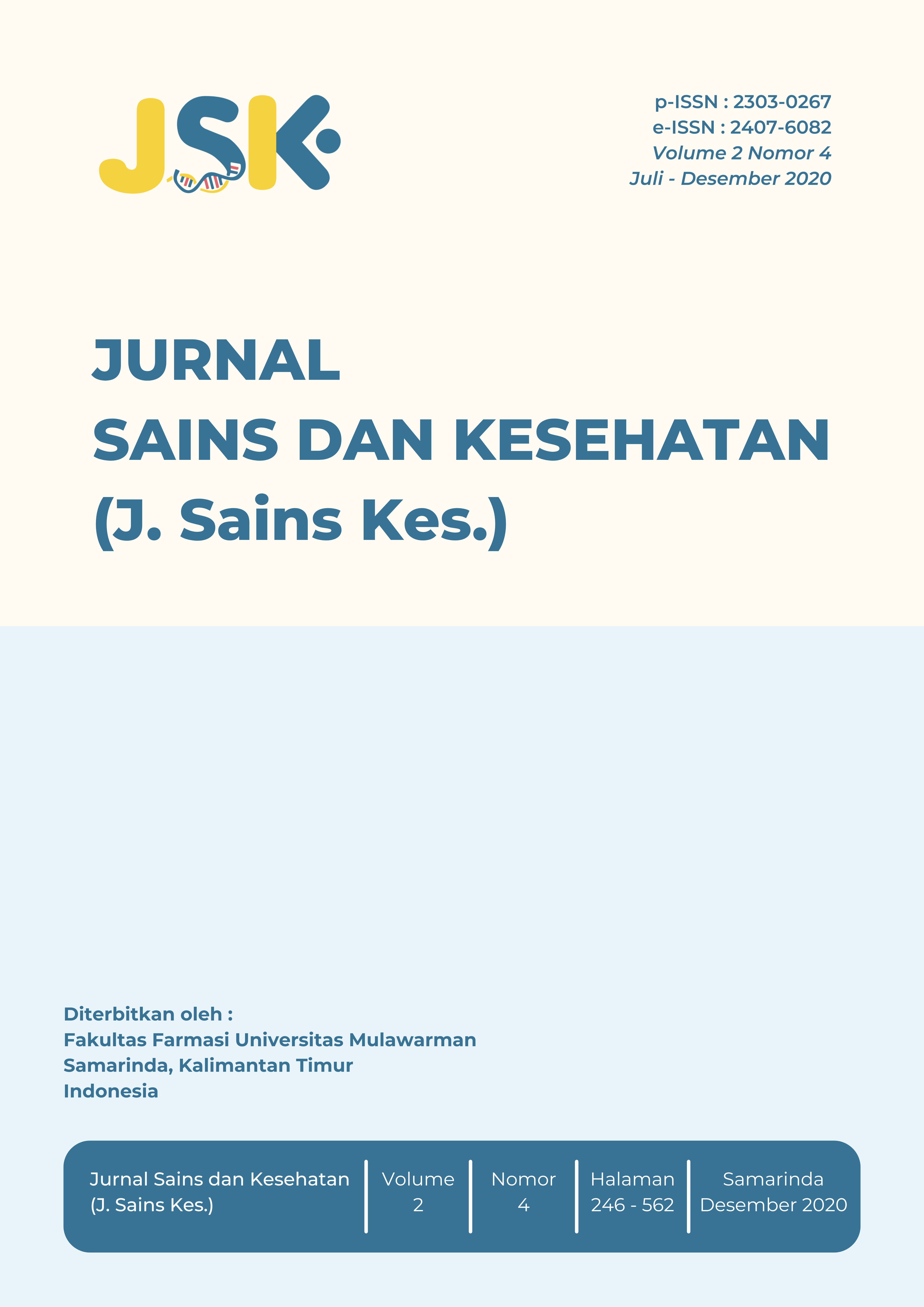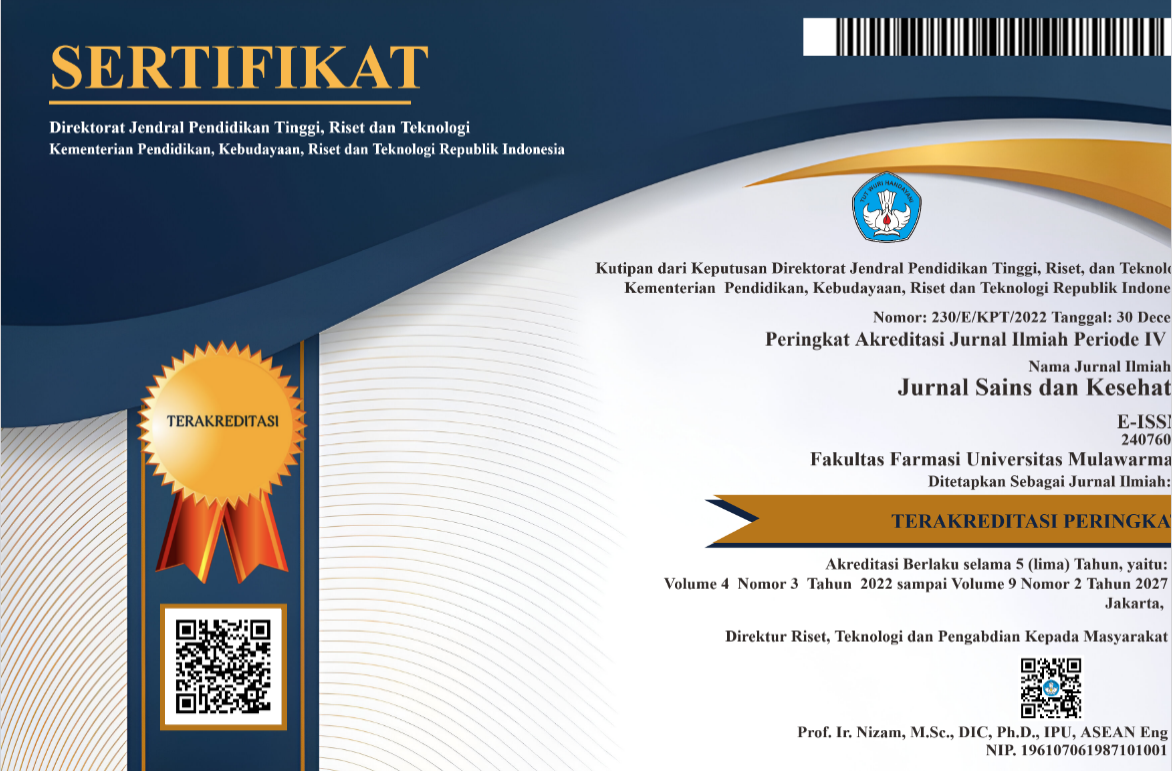Hubungan Usia dengan Kadar Prostate Specific Antigen pada Penderita Benign Prostatic Hyperplasia di Laboratorium Patologi Anatomi RSUD Abdul Wahab Sjahranie Samarinda
Keywords:
usia, kadar Prostate Specific Antigen, Benign Prostatic HyperplasiaAbstract
References
[1] C. A. Mochtar, R. Umbas, D. M. Soebadi, N. Rasyid, B. S. Noegroho, and B. B. Poernomo, “Panduan penatalaksanaan klinis pembesaran prostat jinak,” Ikat. Ahli Urol. Indones., vol. 2, pp. 1–27, 2015.
[2] K. T. McVary et al., “Management of Benign Prostatic Hyperplasia (BPH) Guideline,” AUA Clin. Guidel., 2016.
[3] B. B. Purnomo, “Dasar-dasar urologi,” Jakarta Sagung Seto, pp. 6–9, 2011.
[4] E. D. Yeboah, “Prevalence of Benign Prostatic Hyperplasia and Prostate Cancer in Africans and Africans in the Diaspora.,” J. West African Coll. Surg., vol. 6, no. 4, pp. 1–30, 2016.
[5] W. Wang, Y. Guo, D. Zhang, Y. Tian, and X. Zhang, “The prevalence of benign prostatic hyperplasia in mainland China: Evidence from epidemiological surveys,” Sci. Rep., vol. 5, no. August, pp. 1–12, 2015, doi: 10.1038/srep13546.
[6] D. M. Krisna, A. Maulana, and E. Kresnoadi, “Correlation between Prostate-Specific-Antigen ( PSA ) Level and Prostate Volume in Benign Prostatic Hyperplasia at Bhayangkara Hospital Mataram Daniel M Krisna *, Akhada Maulana **, Erwin Kresnoadi *** * Faculty of Medicine Duta Wacana Christian Universit,” Med. Heal., vol. 1, no. 6, pp. 525–531, 2017.
[7] S. Chasani, “Hipertrofi Pristat Benigna,” in Buku Ajar Ilmu Penyakit Dalam, Jakarta: Interna Publishing, 2014, pp. 2139–2148.
[8] J. Lim et al., “Ethnicity is an independent determinant of age-specific PSA level: Findings from a multiethnic Asian setting,” PLoS One, vol. 9, no. 8, 2014, doi: 10.1371/journal.pone.0104917.
[9] A. Prcic, E. Begic, and M. Hiros, “Usefulness of total PSA value in prostate diseases diagnosis,” Acta Inform. Medica, vol. 24, no. 3, pp. 156–161, 2016, doi: 10.5455/aim.2016.24.156-161.
[10] D. S. Park et al., “Correlation between serum prostate specific antigen level and prostate volume in a community-based cohort: Large-scale screening of 35,223 Korean Men,” Urology, vol. 82, no. 6, pp. 1394–1399, 2013, doi: 10.1016/j.urology.2013.07.071.
[11] T. Antony et al., “Correlation of serum prostate specific antigen with clinical, radiological and pathological variables in patients with prostate enlargement,” Int. Surg. J., vol. 6, no. 12, p. 4408, 2019, doi: 10.18203/2349-2902.isj20195403.
[12] M. Bo, M. Ventura, R. Marinello, S. Capello, G. Casetta, and F. Fabris, “Relationship between Prostatic Specific Antigen (PSA) and volume of the prostate in the Benign Prostatic Hyperplasia in the elderly.,” Crit. Rev. Oncol. Hematol., vol. 47, no. 3, pp. 207–211, Sep. 2003, doi: 10.1016/s1040-8428(03)00094-5.
[13] Y. L. Chang et al., “Correlation Between Serum Prostate Specific Antigen and Prostate Volume in Taiwanese Men With Biopsy Proven Benign Prostatic Hyperplasia,” J. Urol., vol. 176, no. 1, pp. 196–199, 2006, doi: 10.1016/S0022-5347(06)00568-4.
[14] O. Abdelwahab, H. Sherif, A. Eshazly, and M. Zaazaa, “UroToday International Journal,” Laterality, vol. 33, no. 2, p. 94.3, 2010.
[15] A. Alawad, F. Younis, A. M. Eltoum, and S. A. Abdelgani, “Serum prostate-specific antigen as a predictor of prostate volume in Sudanese patients with benign prostatic hyperplasia,” Int. J. Med., vol. 2, no. 1, pp. 3–6, 2014, doi: 10.14419/ijm.v2i1.2494.
[16] K. Devi, A. Frasiska, A. Agung, and G. Oka, “Usia dan obesitas berhubungan terhadap terjadinya penyakit benign prostatic hyperplasia di RSUP Sanglah Bali periode januari 2014 sampai desember 2014,” E-Jurnal Med., vol. 7, no. 1, pp. 2–4, 2018.
[17] B. Suryawan, “Hubungan Usia Dan Kebiasaan Merokok Terhadap Terjadinya Bph,” J. Med. Malahayati, vol. 3, no. 2, pp. 102–107, 2016.
[18] P. Duvedi, H. Singh, G. K. Bedi, and M. Kaur, “Role of Prostate-Specific Antigen (PSA) in Patients with Benign Prostate Hyperplasia,” J. Clin. Diagnostic Res., pp. 15–17, 2019, doi: 10.7860/jcdr/2019/39748.12814.
[19] S. N. Ayyildiz and A. Ayyildiz, “PSA, PSA derivatives, proPSA and prostate health index in the diagnosis of prostate cancer,” Turk Urol. Derg., vol. 40, no. 2, pp. 82–88, 2014, doi: 10.5152/tud.2014.94547.
[20] P. Widayati, G. Mondrida, S. Setiyowati, A. Ariyanto, V. Y. Susilo, and W. Lestari, “PREPARASI PEREAKSI KIT IMMUNORADIOMETRlCASSAY FREE PROSTATE SPECIFIC ANTIGEN UNTUK DETEKSI KANKER PROSTAT,” J. Kim. Terap. Indones., vol. 15, no. 2, pp. 14–24, 2013, doi: 10.14203/jkti.v15i2.107.
Downloads
Published
Issue
Section
How to Cite
Most read articles by the same author(s)
- Syifa Fitria Anggraeny, Boyke Soebhali, Sulistiawati Sulistiawati, Poppy Desra S Nasution, Endang Sawitri, Gambaran Status Konsumsi Air Minum Pada Pasien Batu Saluran Kemih , Jurnal Sains dan Kesehatan: Vol. 3 No. 1 (2021): J. Sains Kes.
- Enggarita Widyahapsari, Hadi Irawiraman, Endang Sawitri, Tingkat Pengetahuan tentang Kanker Payudara dan Perilaku SADARI pada Mahasiswi Prodi Kedokteran Fakultas Kedokteran Universitas Mulawarman , Jurnal Sains dan Kesehatan: Vol. 3 No. 3 (2021): J. Sains Kes.
- Muhammad Fachrian Akbar, Agustina Rahayu Magdaleni, Hary Nugroho, Endang Sawitri, Arie Ibrahim, Pengaruh Irama Sirkadian Terhadap Memori Jangka Pendek pada Mahasiswa Fakultas Kedokteran Universitas Mulawarman , Jurnal Sains dan Kesehatan: Vol. 3 No. 5 (2021): J. Sains Kes.
- Esmaya R. A. Adaniyah, Endang Sawitri, Erwin Ginting, Review: Pengaruh Faktor Risiko Terhadap Induksi Persalinan , Jurnal Sains dan Kesehatan: Vol. 3 No. 6 (2021): J. Sains Kes.
- Sofia Apriyanti, Endang Sawitri, Nur Khoma Fatmawati, Penggunaan Smartphone Berpengaruh Terhadap Gejala Computer Vision Syndrome , Jurnal Sains dan Kesehatan: Vol. 3 No. 5 (2021): J. Sains Kes.
- Hamdi Mayulu, Endang Sawitri, Irsan Tricahyadinata, The Impact of Covid-19 Pandemic on the Livestock Subsector , Jurnal Sains dan Kesehatan: Vol. 5 No. 2 (2023): J. Sains Kes.
- Endang Sawitri, Hermawati Rahman, Hadi Irawiraman, The Relationship Between Physical Activity and Stress Levels With The Menstrual Cycle in Female Students of The Faculty of Medicine, Mulawarman University , Jurnal Sains dan Kesehatan: Vol. 6 No. 3 (2025)
Similar Articles
- Safira Nuraini, Yasmin Sabina Sa'diah, Evi Fitriany, Hubungan Usia Menarche, Status Gizi, Stres dan Kadar Hemoglobin Terhadap Kejadian Dismenorea Primer pada Mahasiswi Fakultas Kedokteran, Universitas Mulawarman , Jurnal Sains dan Kesehatan: Vol. 3 No. 3 (2021): J. Sains Kes.
- Luthfa Hubbalkhairi Ulfa, Andriansyah Andriansyah, Abdillah Iskandar, Hubungan Kadar Hemoglobin Sebelum dan Selama Terapi Radiasi dengan Respon Tumor pada Pasien Kanker Serviks di RSUD Abdul Wahab Sjahranie Samarinda , Jurnal Sains dan Kesehatan: Vol. 3 No. 6 (2021): J. Sains Kes.
- Betty Rachma, Ani Widyastuti, Hubungan Kadar Hemoglobin Terglikosilasi (HbA1c) dengan Estimasi Laju Filtrasi Glomerulus (eLFG) Pasien DM Tipe II di Fasilitas Kesehatan Tingkat Pertama , Jurnal Sains dan Kesehatan: Vol. 3 No. 4 (2021): J. Sains Kes.
- Annisa Salsabila, Carta A. Gunawan, Hadi Irawiraman, Profil Hematologi Pasien Malaria Rawat Inap di RSUD Panglima Sebaya Kabupaten Paser Periode Januari 2015-Maret 2018 , Jurnal Sains dan Kesehatan: Vol. 3 No. 4 (2021): J. Sains Kes.
- Tantri Rachmayani, Akrom Akrom, Titiek Hidayati, Pengaruh Minyak Biji Jinten Hitam (Nigella sativa L) terhadap Kadar Interleukin-4 , Jurnal Sains dan Kesehatan: Vol. 3 No. 6 (2021): J. Sains Kes.
- Aliya Khadijah Kemaleratu, Yuliana Rahmah Retnaningrum, Yudanti Riastiti, Tingkat Keberhasilan Terapi Radioiodin Pertama pada Pasien Graves’ Disease , Jurnal Sains dan Kesehatan: Vol. 6 No. 1 (2025)
- Rifatolistia Tampubolon, Jeanita Fernanda Lasamahu, Bagus Panuntun, Identifikasi Faktor-Faktor Kejadian Anemia pada Ibu Hamil di Kecamatan Amahai Kabupaten Maluku Tengah , Jurnal Sains dan Kesehatan: Vol. 3 No. 4 (2021): J. Sains Kes.
- Hurria Maulana Ali, Annisa Muhyi, Yudanti Riastiti, Hubungan Usia, Kadar Hemoglobin Pretransfusi dan Lama Sakit terhadap Kualitas Hidup Anak Talasemia di Samarinda , Jurnal Sains dan Kesehatan: Vol. 3 No. 4 (2021): J. Sains Kes.
- Imanuel Saputra Sembiring, Dewi Rahmawati, Adam M. Ramadhan, Analisis Efektivitas Biaya dan Minimal Biaya Pasien Diabetes Melitus Tipe 2 di RSUD Abdul Wahab Sjahranie Samarinda Tahun 2019 , Jurnal Sains dan Kesehatan: Vol. 4 No. 3 (2022): J. Sains Kes.
- M. Akbar Rizqullah Rusydi, Ivan Joalsen Manggara Tua, Agustina Rahayu Magdaleni, Hubungan Kadar Hemoglobin Sebelum Operasi dengan Kebutuhan Transfusi Sel Darah Merah Intra Operasi pada Pasien Bedah Pintas Arteri Koroner di RSUD Abdul Wahab Sjahranie Samarinda , Jurnal Sains dan Kesehatan: Vol. 4 No. 2 (2022): J. Sains Kes.
You may also start an advanced similarity search for this article.




